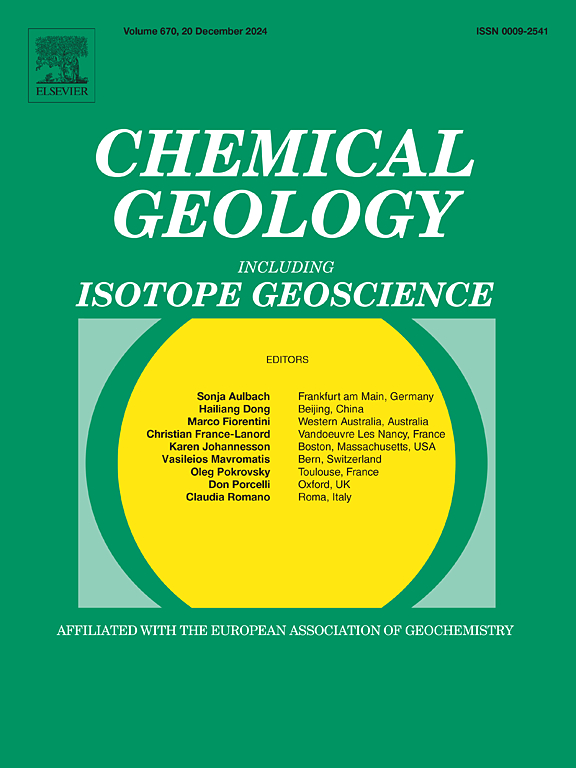Secular compositional changes in granitoids and felsic volcanics: the tectonic setting control
IF 3.6
2区 地球科学
Q1 GEOCHEMISTRY & GEOPHYSICS
引用次数: 0
Abstract
This study presents results for secular compositional change of 12 geochemical variables in granitoids and felsic volcanics in the last 3 Gyr grouped into two tectonic settings, orogenic and within-plate. Time series are constructed from median values of geochemical data compiled in 250-Myr bins. Within-plate granitoid and felsic volcanic time series (high SiO2, (Na2O + K2O)/CaO, Fe Index, Y + Nb, Ga/Al; low Sr/Y, Eu/Eu*, La/Nb) are displaced from the orogenic series, consistent with shallow depths of magma generation and an overall lower degree of partial melting or/and more fractional crystallization for within-plate magmas through time. Orogenic granitoid and felsic volcanic geochemical time series for La/Yb, Th/Yb, La/Nb, Y + Nb, and Yb are similar and show a transition at the end of the from dominantly restitic garnet-amphibole-rutile to plagioclase control, the latter reflecting shallower depths of magma generation. Relatively high Eu/Eu* in Archean granitoids and felsic volcanics (and high Sr/Y in Archean granitoids) may imply that plagioclase accumulation is more effective before 2.5 Ga than afterwards, consistent with large volumes of TTG (tonalite-trondhjemite-granodiorite) in the Archean. Low Sr/Y and Eu/Eu* of granitoids and felsic volcanics in the last 1750 Myr likely require significant plagioclase removal by fractional crystallization or/and plagioclase presence in the melting restite. Fractionation of Th from La beginning at 1500 Ma may reflect a change to an apatite-dominated restite, perhaps in response to greater amounts of subducted P-rich sediments entering the sources of felsic magma. Increases in Yb, Y + Nb, and Fe Index and decreases in La/Nb, Eu/Eu*, Sr/Y, La/Yb and Th/Yb in orogenic settings during assembly of Columbia (1800–1500 Ma) reflect shallowing of magma sources, perhaps in hot back-arc basins. Our findings show the importance of tectonic setting on the compositional evolution of felsic magmas, highlighting the need to consider the differences between orogenic and within-plate processes when reconstructing the compositional history of the continental crust into deep time.
花岗岩类和长英质火山岩的长期成分变化:构造背景的控制
摘要本文研究了近3 Gyr花岗岩类和长英质火山岩中12个地球化学变量的长期组成变化,并将其划分为造山带和板内构造环境。时间序列由250-Myr箱中收集的地球化学数据的中位数构建。板内花岗岩类和长英质火山时间序列(高SiO2、(Na2O + K2O)/CaO、Fe指数、Y + Nb、Ga/Al;低Sr/Y、Eu/Eu*、La/Nb)从造山带中移出,与岩浆生成深度较浅、板块内岩浆部分熔融程度较低、部分结晶程度较高一致。La/Yb、Th/Yb、La/Nb、Y + Nb和Yb的造山花岗岩类和长英质火山地球化学时间序列相似,并表现出由以弹性石榴石-角闪石-金红石为主向斜长石为主的过渡,后者反映出岩浆生成深度较浅。太古宙花岗岩和长英质火山岩中较高的Eu/Eu*(以及太古宙花岗岩中较高的Sr/Y)可能表明,在2.5 Ga之前斜长石的聚集比2.5 Ga之后更有效,与太古宙中大量的TTG(闪长岩—闪长岩—花岗闪长岩)相一致。1750 Myr晚期花岗岩类和长英质火山岩的低Sr/Y和Eu/Eu*可能需要通过分馏结晶去除大量斜长石或/和熔融岩中存在斜长石。从1500 Ma开始,La中Th的分馏可能反映了一个以磷灰石为主的耐蚀岩的变化,这可能是对大量俯冲富p沉积物进入长英质岩浆源的反应。在哥伦比亚组合时期(1800 ~ 1500 Ma),造山带中Yb、Y + Nb和Fe指数升高,La/Nb、Eu/Eu*、Sr/Y、La/Yb和Th/Yb指数降低,反映了岩浆源的浅化,可能是热弧后盆地。我们的发现显示了构造环境对长英质岩浆组成演化的重要性,强调了在深时间重建大陆地壳组成历史时需要考虑造山作用和板块内作用的差异。
本文章由计算机程序翻译,如有差异,请以英文原文为准。
求助全文
约1分钟内获得全文
求助全文
来源期刊

Chemical Geology
地学-地球化学与地球物理
CiteScore
7.20
自引率
10.30%
发文量
374
审稿时长
3.6 months
期刊介绍:
Chemical Geology is an international journal that publishes original research papers on isotopic and elemental geochemistry, geochronology and cosmochemistry.
The Journal focuses on chemical processes in igneous, metamorphic, and sedimentary petrology, low- and high-temperature aqueous solutions, biogeochemistry, the environment and cosmochemistry.
Papers that are field, experimentally, or computationally based are appropriate if they are of broad international interest. The Journal generally does not publish papers that are primarily of regional or local interest, or which are primarily focused on remediation and applied geochemistry.
The Journal also welcomes innovative papers dealing with significant analytical advances that are of wide interest in the community and extend significantly beyond the scope of what would be included in the methods section of a standard research paper.
 求助内容:
求助内容: 应助结果提醒方式:
应助结果提醒方式:


